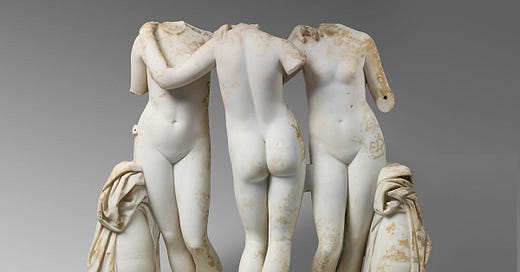This Roman statue of the Three Graces dates back to the 2nd century BC, and is currenetly in the Metropolitan Museum of Art’s collection.
The are Beauty, Mirth, and Abundance, and “bestow what is most pleasurable and beneficent in nature and society.”
The Three Graces are referenced extensively through art history - three women shown together, often in this kind of connected/intertwined pose. It’s canonical - a repeated, easily recognizable theme/image in art history. The canon is the group of artworks/artists traditionally considered “great,” standard, primary sources (something to consider is who decides what’s in this canon…it’s an awful lot of white men from Western Europe!).
Look out for them
Think about them next time you go to a museum. They’re all around! Maybe now you’ll recognize them and notice another artist referencing this group of ladies.
Here’s a nice walkthrough of other artists using them: Three Graces in Art History
Read more
Art History With Heather post about Botticelli’s Primavera (featuring 3 graces!)




Even as a classicist, I didn't know the names/personified traits of the Graces! this is such a beautiful work—thanks for sharing.